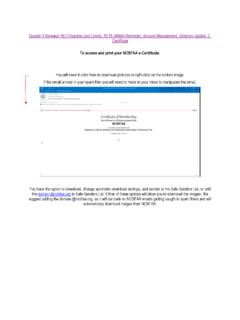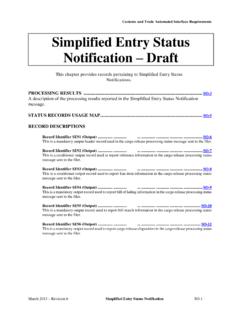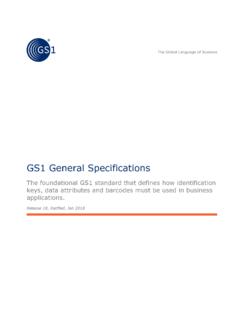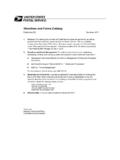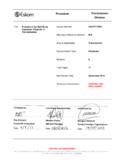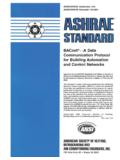Transcription of U. S. CUSTOMS AND BORDER PROTECTION …
1 Version U. S. CUSTOMS AND BORDER PROTECTION business rules and process document (Trade) ACE Entry Summary business rules AND process (TRADE) ACE Entry Summary CUSTOMS AND BORDER PROTECTION Office of International Trade 1400 L Street NW Washington, DC 20229 1 Table of Contents Background 1 System Edits and Validations 2 Entry Summary Record is Ccreated in ACE 2 Entry Summary Cancellation 5 Methods of Response to System Generated Notification 6 Single Transaction Bond 7 Electronic Invoice Processing in ACE 7
2 Entry Summary Team Review 8 Blanket Declaration Records in the ACE Portal 12 Post Summary Correction 18 AD/CVD Case Management /Messages 22 Liquidation of ACE Entry Summaries 28 ACE Entry Summaries Flagged for Reconciliation 30 Protest Filing for ACE Entry Summaries 30 ACE Policy document Updates 31 ii Automated Commercial Environment Entry Summary Processing Overview he purpose of this document is to outline entry summary processing in the Automated Commercial Environment (ACE). Processing entry summaries in ACE will change the system of record for these import related transactions from a paper-based system to a true electronic system of record keeping.
3 A change of this significance requires revised operational policies and procedures and this document will address those changes. This document will be a living document as the different entry summary types and associated downstream processing migrate from the Automated Commercial System (ACS) to ACE. ACE ESAR Release This document coincides with the ACE Entry, Summary, Account, and Revenue (ESAR) Release The Federal Register Notice (FRN) published December 30, 2009 outlines specific National CUSTOMS Automation Program (NCAP) Test participant eligibility requirements. The FRN dated March 6, 2009 announced the deployment plan for the test which preceded this release. Entry summaries filed in ACE must be filed via the Automated Broker Interface and paid via statement processing. Entry types 01-consumption, 03-antidumping/countervailing duty (AD/CVD), and 11-informal are the only entry types allowed to be filed in ACE at this time.
4 This document has been updated to reflect the functionality specific to the filing and processing of post summary corrections (PSC s). A PSC may be filed for entry summaries filed on and after the PSC deployment date. Background The process governing the importation of goods into the United States, generally speaking, is a two-part process consisting of : 1) filing the cargo release documents necessary to determine whether merchandise may be released from CUSTOMS and BORDER PROTECTION (CBP) custody, and 2) filing the entry summary documents that pertain to merchandise classification, duty, taxes, and fees. Currently, over 99 percent of all entry summaries are filed electronically using the Electronic Data Interchange (EDI). The interface system that allows EDI transmissions to CBP s automated systems is the Automated Broker Interface (ABI). Entry summaries are categorized into several entry types to facilitate more effective processing and management of these transactions.
5 Ninety-six percent of all entry summaries filed are type 01-consumption and type 11-informal. Consumption entries cover mostly commercial shipments and are typically supported by a surety bond to ensure compliance and payment of duties, taxes, and fees. Informal entries are typically low-dollar valued commercial and personal imports that are also being entered into the United States for consumption. In general, informal entries are valued $2,000 or less unless the goods are subject to import restrictions for which other rules apply. process Icons The process icons are embedded throughout this document to indicate when either the filer or the CBP is initiating an action. System actions will also be indicated. T ICON KEY Filer initiated action * CBP initiated action System action Offline process 1 System Edits and Validations Filer generates and submits entry summary transaction via ABI to ACE.
6 EDI transmission is validated based on syntax rules . Entry summary control status is Trade during this processing. Syntax validation fails entry summary is rejected back to filer via ABI. Syntax validation passes entry summary proceeds to validation for Filing Action and Control rules . Entry Summary Filing Action and Control Validation Performed after syntax validation and entry summary transmission is accepted without conditions. Validation of the entry summary header data Census edit processing-all ACE entry summaries may be reviewed by the Department of Census. CBP will not accept paper census warning sheets for ACE entry summaries. Entry summary Census edit process can result in no errors. Entry summary Census edit processing can result in a Census warning and the filer may correct or enter Census Warning Override code and retransmit. Filer may enter preemptive Census Warning Override code at initial transmission when it is known in advance that shipment parameters are outside of Census parameters for a valid reason.
7 Validation of entry summary line item data Validation of entry summary port line and totals Entry Summary record is created in ACE Entry summary status is indicated as Accepted. The EDI transmission is accepted by ACE. Entry summary control status continues to be Trade. ACE does not track versions of the entry summary until the preliminary daily statement is generated for the entry summary when entry summary control status is updated to CBP (See ). Trade users may make revisions to the ACE entry summary while the entry summary is in Trade control 2 through the Add or Replace function. Authorized CBP users can only modify an entry summary that is in CBP control through the ACE Portal. The number to the right of the decimal in the version number will increase ( , v ) and the changes are captured in the entry summary change history. The change history will capture cumulative changes to an entry summary by CBP users.
8 Trade users may make changes to the entry summary after it is in CBP control, for example, when the entry summary is rejected back to the filer. When the filer makes a revision, it will result in the number to the left of the decimal within the version number increasing ( , v. ). If an entry summary is in CBP control, the filer cannot perform the Add , Replace , or Delete functions to that entry summary. Trade users will have visibility to the entry summary version numbers through the ACE Portal reports. The filer remains responsible for the record keeping requirements found in 19 CFR 163. This is the first point in the process where ACE interfaces with ACS. This synchronization between ACE and ACS will occur continually throughout ACE entry summary processing. ACE writes entry summary data to ACS for cargo release and collection processing. Cargo release processing occurs in ACS for ACE entry summaries requesting cargo release certification.
9 Collection processing occurs in ACS. Once a preliminary daily statement (periodic daily or regular daily) is generated for the entry summary, entry summary control is updated to CBP. Entry summary versioning begins at this point and the filer can no longer make changes to entry summary data transmitted without CBP intervention. The payment/collection status of an entry summary is determined in ACS, and ACE receives the status update through the ACE-ACS interface. Whenever there is a collection status update in ACS, the changes are updated in ACE. Once an entry summary control status is CBP , the entry summary version and subsequent changes are logged. The change history will capture cumulative changes to an entry summary. Trade users will have visibility to the entry summary version numbers through the ACE Portal reports.
10 3 ACE entry summaries must be paid via statement processing. There may be extenuating circumstances when an ACE entry summary must be removed from a statement. Filer will submit ABI transmission to remove the entry summary from statement processing. The entry summary control will be changed from CBP to Trade. Once the debit authorization is processed for a statement the filer cannot move an entry summary from that statement to another statement. Single pay is the only option for the entry summary taken off the statement in this case. If entry summary is not posted to another statement, then filer will submit a transmittal form (a new test form - CBP Form 7501T) or the first page of the CBP Form 7501 along with the single payment at the respective processing port of entry. The unique identifier will be the entry number. Once collection is processed by CBP, entry summary control will change from Trade to CBP.
